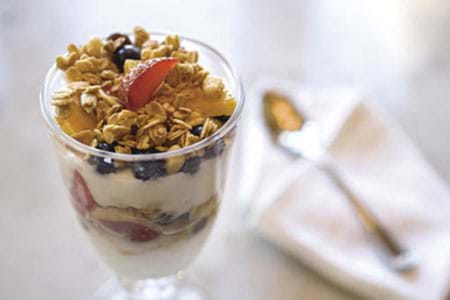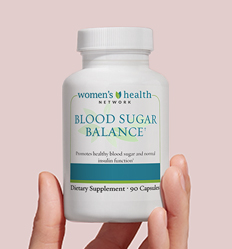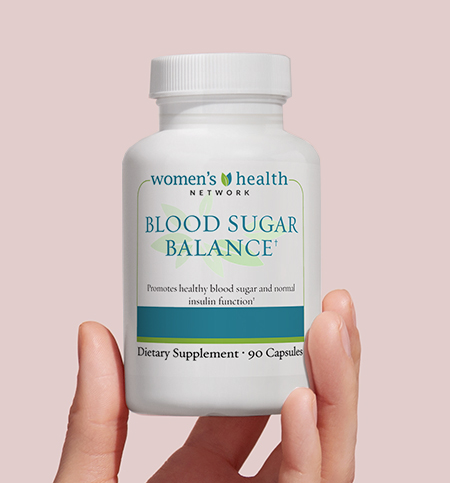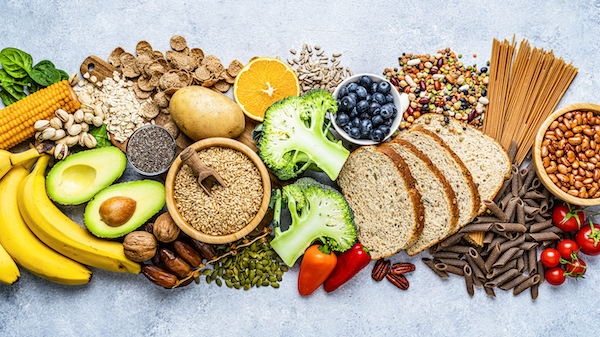Reviewed by Dr. Amber Hayden, DO
“Your blood sugar is high.” Every day women are told their blood sugar — or blood glucose — is elevated but don’t know what they should do about it. Elevated blood sugar — or hyperglycemia — should not be ignored because it can lead to some terrible problems:
- Severe dehydration
- Infection
- Blood clots
- Pancreatitis
- Diabetes
- Nerve and organ damage
- Heart attack or stroke
We recommend discussing your elevated blood sugar lab results with your healthcare practitioner to understand what effect they may have on your health. And it’s good to know that there are steps you can take, starting today, that will have a positive impact on your blood glucose levels.

Healthy blood glucose balance in 4 steps
Your body really wants blood sugar levels to stay steady within a particular range — not too high, not too low. But blood sugar is influenced continually by what you eat — the impact of food on blood glucose is almost immediate. Lifestyle also plays an important role in blood sugar metabolism because glucose is a major fuel for your body, and is about the only fuel your brain can use.
You can harness the power of diet, lifestyle and information to help your body find and maintain healthy blood glucose balance.
Step #1: Eat fiber and protein whenever you have carbohydrates.
Adding fiber and good quality protein slows down sugar metabolism. Any sugar you eat — including carbs — moves into your blood. Your pancreas makes insulin to absorb the sugar to use as fuel now or store for later. Blood sugar levels fall as cells absorb the sugar.
When it’s time, your pancreas makes the hormone glucagon to tell your liver to release some of the stored sugar. Insulin and glucagon go back and forth this way working to ensure a steady supply of glucose to both your body and your brain. “Simple” carbohydrates — cookies, fruit juice, honey, etc. — are broken down so quickly that they can jack up both blood sugar and insulin production too fast. That leads to a rapid drop in blood glucose after that big spike.

“Complex” carbs like vegetables, whole grains and even potatoes have enough fiber that it takes longer to break them down, slowing the process and preventing a blood sugar spike. Protein is different and, along with fat, it keeps blood glucose stable. A diet of 30% protein, 40% carbs and 30% fat can lower the absorption rate of sugar — even in people who already have type 2 diabetes. Well-balanced meals help you achieve the 30-40-30 ratio but be careful with snacks, which can be sugar-filled.
Best carb snacks with fiber and protein: string cheese with whole wheat crackers; almonds and dried, unsweetened cranberries; hummus and carrot sticks; Greek yogurt with dried fruit or granola; chicken noodle soup; banana-strawberry smoothie. Our favorite is a toasted mini whole-grain pizza with veggie toppings and an ounce of shredded cheese.
Step #2: Corral your carbohydrate consumption.
Keeping track of your carbs is a key element in dealing with elevated blood sugar. Carbohydrates have gotten a bad name mostly because lots of us are eating too many “simple” carbs with empty calories that can spike blood sugar and pack on the pounds. But we all need carbohydrates to survive and to help balance blood glucose.
The kind of carb you eat, how often and when you eat it all matter a lot. When it comes to their impact on your blood sugar, carbohydrates exist on a spectrum. Some carbs provide quick energy and raise blood sugar, but then you and your blood sugar “crash.” Carbs with good fiber and necessary nutrients take longer to break down so you avoid the blood sugar spike. If your blood sugar is elevated, take a look at the carbohydrate spectrum so you can choose foods wisely.

Step #3: Get to know the glycemic index of foods.
If you have elevated blood sugar, take advantage of two key ways to figure out how foods will affect your blood glucose before you eat them:
1. Glycemic index (GI) measures how much specific foods raise blood glucose after you eat them.
2. Glycemic load (GL) tells you both how much sugar a food puts into your bloodstream and how fast it does it.
The GL and GI can help you choose what to eat, and when to eat it. While blood sugar and insulin levels move up and down naturally throughout the day, it’s better if the changes aren’t extreme. Using these two guides, it doesn’t take long to interpret the glycemic effects of a slice of cake versus a handful of strawberries. Both are sweet treats but the strawberries have a low glycemic index and the cake has a high GI.

Step #4: Go on a walk today — and another one tomorrow, and also the day after that.
Exercise is your best friend if you have elevated blood sugar. Research shows that just 10 minutes of exercise, especially right after meals, can bring blood sugar levels down 22%, and that’s in people who already have type 2 diabetes. The official recommendation for adults is at least 30 minutes of exercise five days per week.
Physical activity helps improve how insulin works and lets muscles make better use of sugar for energy while it actually decreases your risk of developing type 2 diabetes. And some studies say that the more exercise you do, the lower your risk for type 2 — the kind of diabetes that can often be controlled, and sometimes reversed, with diet and exercise.
If you’re overweight — one big factor in type 2 diabetes — exercise can help you drop excess pounds. Just a 5% weight loss shrinks your risk of type 2 diabetes. If your blood sugar is high, now is the time to add regular exercise to your schedule — even if it’s just a 10-minute walk after dinner.
Bonus Step: Ditch the soda — even if it’s diet!
Solid research from Sweden shows clearly that just 2 small (200ml) daily servings of sweetened drinks — regular or artificially sweetened — can double your risk of developing diabetes. And 5 or more daily single servings of soda raise your risk of type 2 by 10 times. Even small increases move you toward diabetes. Since artificial sweeteners are 600 times sweeter than sugar, regular consumption makes you want more.

You can build a lifestyle that supports healthy blood sugar balance
Even though your lifestyle habits may seem impossible to change, having elevated blood sugar can be the motivation you need to make better choices every day. If you have elevated blood sugar, we encourage you to get more information from your doctor about what’s right for you.
If you begin shifting your diet away from simple carbs and start getting some exercise every day, you will see a difference in your blood sugar sooner than you think. And with the changes you’ve made, you might end up loving the way you feel.
https://www.drugs.com/cg/hyperglycemia-non-diabetic.html
https://www.ncbi.nlm.nih.gov/books/NBK22436/
https://www.hsph.harvard.edu/nutritionsource/carbohydrates/carbohydrates-and-blood-sugar/
https://healthyeating.sfgate.com/fats-proteins-affect-blood-sugar-levels-11172.html
https://www.everydayhealth.com/hs/phototgallery-type-2-diabetes-10-best-snacks/
https://www.glycemicindex.com/testing_research.php
https://www.health.harvard.edu/diseases-and-conditions/glycemic_index_and_glycemic_load_for_100_foods
https://www.health.harvard.edu/use-glycemic-index-to-help-control-blood-sugar-201208135154
/blood-sugar/how-to-use-glycemic-index-and-glycemic-load/
https://abcnews.go.com/Health/studies-suggest-benefits-exercise-people-type-diabetes/story?id=42874203
Smith A, Crippa A, Woodcock J, et al. Physical activity and incident type 2 diabetes mellitus: a systematic review and dose–response meta-analysis of prospective cohort studies. Diabetologia 17 October 2016. pp 1–19. https://link.springer.com/article/10.1007/s00125-016-4079-0 Accessed on 10.25.16.
Gregg E, Chen H, Wagenknecht L, et al. Association of an Intensive Lifestyle Intervention With Remission of Type 2 Diabetes. JAMA. 2012;308(23):2489-2496. https://jamanetwork.com/journals/jama/fullarticle/1486829 Accessed 10.25.16.












